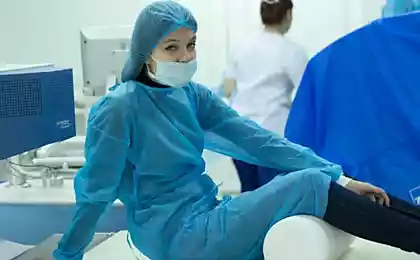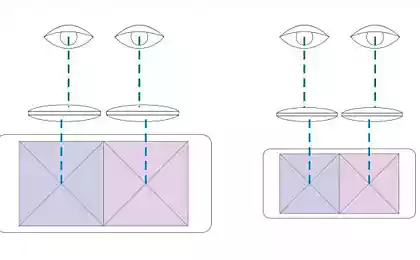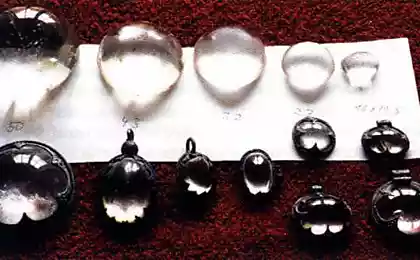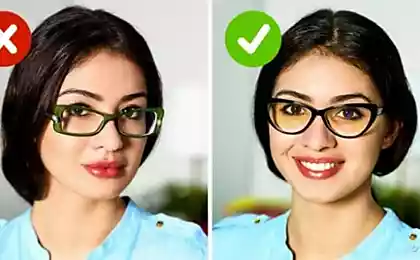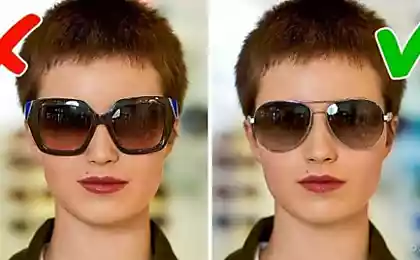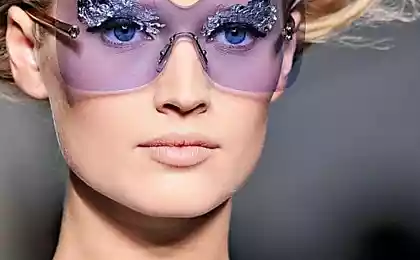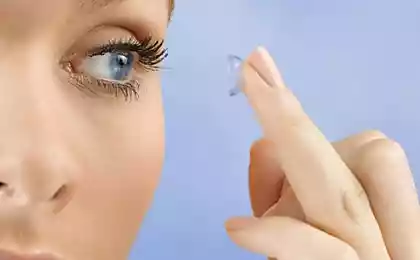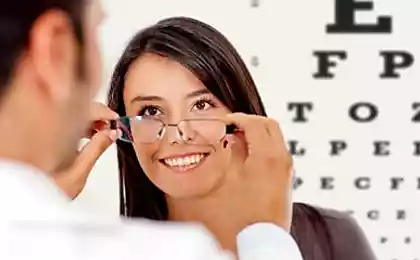Orthokeratology: the annual experience of using the night lens
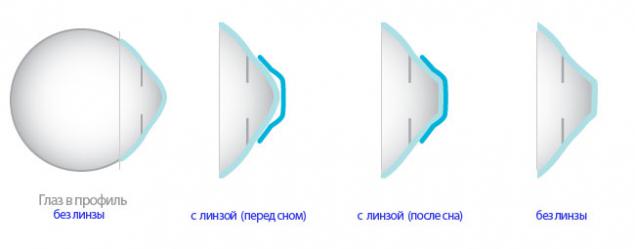
About 50% of the population does not have 100% vision - let alone among IT people and geeks who stay for close supervision screens of different sizes, this percentage tends to hundred. Currently there are several methods of vision correction.
I've tried almost all of them, and at the request of the public describe his personal experience. Also I was "lucky" to get almost all the schools that may be encountered on the way the owner of orthokeratology lenses, so my experience may be useful for those who think about their use.
Points h4> Points known about since the 13th century. The lenses that compensate the shortcomings of view, are in frame and hang on the nose shortsighted person. Previously, people also used such variants as monocles and pince-nez, but today has moved into the last category of atavism.
With these crutches for the eyes I know since high school - from the moment when it became clear that I do not see the writing on the blackboard even from the front row. I think that this device is more or less familiar to all.
Pros points h5> • someone like the look of a man with glasses; I understand that many of today's fashionistas, hipsters even wear glasses without compensation, simply because of the rim
• constant wearing glasses is quite difficult to leave somewhere, or forget to take along for the ride
• less likely to get insects or other foreign objects in the eye
Cons points h5> • rim presses on the skin and rub it into the ground contact
• the person is automatically attached to the image of the "four-eyes»
• even aspherical lenses distort the image
• long work at the computer glasses visibly tired eyes
• They misted the transition between rooms with different temperatures and humidity
• they must be periodically cleaned to remove sebum and other contaminants
• In the rain they interfere Review
• Do not allow normal peripheral vision
• awkward movement can be knock down, drop, smash
• hampered by extreme sports, the use of motorcycle helmets and the like
• with a strong difference in vision between the two eyes is often impossible to complete the correction
I think that fellow bespectacled gladly add to the list.
Eye h4> The first contact lens made in the 19th century, but at that time it was glass products, which have been quite uncomfortable in the eye. Plastic soft lenses began to emerge from the 1960s, and more recently, science offers more and better lens. They get used to it pretty quickly, and foreign body sensation in the eye disappears.
After I got tired of points, I tried to use contact lenses. I just got in the situation where the difference between the two eyes in vision over 1, 5 diopters, which leads to impossibility of complete correction of vision in both eyes. The one eye that sees worse, do not get 100% correct.
Modern lenses even for people with astigmatism are sold at an affordable price (spending a month on disposable, hygienic and very simple to use, is about 3000 rubles). According to the manufacturer, the material of modern lenses transmits nearly all of the oxygen to the cornea and do not undermine.
Pros contact lenses h5> • removed all the disadvantages of glasses; list them again makes no sense
• relatively easy to handle, learn how to shoot and put
• disposable lenses require no maintenance
• Full compensation for both eyes with a different vision
Cons contact lenses h5> • must not forget to take them with you if you send somewhere out of the house, including all accessories - the capacity for storage, cleaning fluid (in the case of reusable lenses), rewetting drops
• if you are unexpectedly turned out, you can stay without lenses
• in case of loss or theft as there are inconveniences
• you must have a moisturizing drops, especially for people with "dry eye syndrome»
• There should be a few days to get used to wearing the lenses, gradually increasing the daily wearing time
• In case of contact with mote in the eye turns pain more intense than in the eyes without lenses
• theoretical lens can knock headshots ball or wash with water when bathing
• hiking and walking expedition with lenses uncomfortable - hard to wash your hands clean, you need to drag with extra fluids and home
• Do not use during illness with fever
The use of contact lenses have passed for me is not very good, they are constantly "ёrzali" in the eyes, required copious "watering" (because of the "dry eye syndrome"), and as a result I could not get used to them.
Night lenses h4> met somewhere in the description of the night lenses, I was interested in them and studied the issue. They are also called ortho-lens, lens night, ОК-линзы. Their essence is that they are used at night. Because these lenses are made from a hard (but gas-permeable) plastic, per night in a predetermined manner, they are restructuring the corneal epithelium.
The mechanism of correcting myopia orthokeratology - is reshaping the corneal epithelial cells under the lens. Hydraulic power behind the lens by the tear layer on the exposed surface of the cornea cells. Those, in turn, is gradually flattened in the center and at the periphery of the cornea increases. Change the shape forms a natural lens that compensates the shortcomings of view. That is, these lenses are put on in the evening, just before going to bed, and removed in the morning, immediately after waking up.
The normal anatomy of the cornea and the integrity of its layers is not violated. The changes are so small (10-30 microns) that they may detect only a special apparatus. However, these changes enough to see well all day without glasses or contact lenses.
The first attempts at producing such lenses were made back in the 60s and in the 80s there has been the prototype of the modern OK lenses, which became possible to produce on CNC machines. Gradually there were devices for accurate measurement of the geometry of the cornea and rigid gas permeable materials.
Here in Russia, such lenses have appeared at the beginning of this century. According to ophthalmologists involved in them, these lenses contribute to the inhibition of the development of myopia in children and adolescents.
It sounded all this is quite fantastic, but I still decided to try this method as an alternative to expensive method final correction LASIK (I, after talks with ophthalmologists, a little afraid).
Selection and use h5> The lenses are made to order, after the measurement of all parameters of the eye using special equipment in ophthalmic offices. To the Moscow firm, which I returned, conditions of service were as follows: The patient pays the cost of the lenses and the cost of the survey once, after which it is possible to visit the office of an ophthalmologist in case of any questions or problems, free of charge and unlimited number of times. This assigns an ophthalmologist periodic inspection every 3 months.
Cost of services amounted to about 17 thousand rubles, of which about 3 thousand. - Is the payment of a doctor, and 14 th. - The cost of manufacture of the two lenses. The lenses are for one year with proper handling them.
In the office there is a decent set of ready-made lenses and if you have a vision and the eye is not too problematic, there is a chance that you will pick up them on the spot. I, of course, it was not so easy, and the lenses had to order (production time - 3-4 working days).
It turned out that such lenses for a long time to get used. Because they are hard, they are felt in the eye, like a foreign body. However, with their eyes closed, even from the early days, I almost did not feel - and since I sleep with his eyes closed, it is not a problem. Furthermore, the cumulative effect of the lenses - immediately after the first few days of sight will not be 100%. The result appears after a few weeks of continuous wear.
Although these lenses are designed for overnight wear, they can function perfectly - they correct vision immediately after putting in the same way as a conventional contact. But a sense of them in the eye with the eyelids open need to get used to. They say it is possible - after all, people with complex problems and have to wear hard contact lenses during the day. I'm such a purpose does not put. But it is quite possible in the evening, wearing lenses for something else to read, and in the morning, did not immediately took off, too, something about it.
During the initial selection of lenses I put them in the eyes and I sat in the waiting room for half an hour - after this time it begins the first effects of which can be estimated using the equipment. For a normal correction of the effect, which will last throughout the day, you need to wear them for at least 8-9 hours a night.
Depending on the strength of the effect can be maintained longer. Generally, the lenses are indicated for myopia up to -6 diopters and astigmatism to -1, 5 diopters (though virtually every month there are new possibilities and boundaries are shifted). If your myopia is not very strong, you can wear them through the day. Even I, with my -4, after a few nights of continuous wear lenses can not wear them for one night and the next day I am quite able to work at a computer, drive a car, etc. So, if I'm lucky, and suddenly I'm staying at someone to spend the night, the next day I did not need help to get home.
After selection of lenses doctor checks that they are properly "sat down" after the first full night with them. It is necessary to put them in the evening to sleep and in the morning without having to remove to get to the doctor. It checks the fit and the other parameters.
The surprise was the process of removing the OK-lenses. They put on and take over the mirror on the table. Wear them as easily as the contact. But simply remove the "pinch" will not work - they are hard. There are special sticks with suction cups that can be removed, but the ophthalmologist not recommend this method as traumatic.
Removed lens in 3 stages. In the morning, when night "glued" to the eyes, you need to moisten them well drops. After a few minutes to massage the area around the lens, so that the drops fell under them. And then you can remove them by pulling a finger century, both so that the edges of eyelids put pressure on the edge of the lens. Then the lenses "popping" of the eye. With the habit - and can on the floor, so I dropped them several times. Normally I start getting this procedure is only three weeks to four. The finger of one hand tightens the eyelids, and the other hand catches flies the lens into the palm.
If too zealously try to remove the lens when it is not quite "otlipla" can damage the cornea. And I, of course, also did. Nothing really terrible was - a few days had to take a break and drip special healing drops.
Since the reusable lenses, they must be stored and cleaned. There are two storage options. One - the usual liquid storage of lenses, and daily cleansing with a special liquid soap.
The second - a liquid based on hydrogen peroxide, in which the lenses are stored in a special container with a solid catalyst. The reaction yields bubbles contributing to mechanical cleaning of the lens. In this case, the liquid soap to wash the lens is necessary, but only once a week.
The second method is more convenient, but it does have one drawback. Because the reaction produces a gas bottle storage do leaking. If it is inverted, fluid flows out of it. So travel with him problematic. If you travel by car, then it is possible to come up with a box in which it is securely fastened. But in the campaign or just a trip with a suitcase and a backpack will already be difficult.
If the cornea is the eye sensitive (of course, I ran on it), the eyes get tired of these lenses overnight. However, there is a miracle cure "Korneregel" designed to restore the cornea, the periodic use of which solves this problem.
When the dim light and at dusk I have observed the effect of the "halo" around the bright or glowing objects. Ophthalmologist explained by the fact that the correction of the cornea affects only a small central area of the eye. With a lack of lighting pupil wide open and the light begins to be refracted through the eye area, not subject to correction. To this effect, amid all the advantages I have used.
Pros OK lenses h6> • in the same way as in conventional lenses, removed all the disadvantages points
• the day you feel in every sense, as a person with normal vision
• rewetting drops during the day do not need
• mote, dust, water, and other factors do not bring any additional problems
• In comparison with LASIK, the effect is reversible. Stop wearing lenses - all recovered, a maximum of 3 days
Cons OK lenses h6> • must not forget to take them with you if you send somewhere out of the house, including all accessories - the capacity for storage, cleaning fluid, moisturizing drops
• it is advisable not to sleep without them more than once
• There should be a few weeks to get used to the procedure for removal
• trekking and expeditions and walking uncomfortable
• Do not use during illness with fever
• to good effect and with poor vision should be worn 8-9 hours - people sleeping for 5-7 hours, it will be difficult
• recovery of the effect is not immediate and is only present at a more or less continuous use of lenses
• if in a dream at night to rub the eyes, it can rub or damage the cornea
• Do not sleep face into the pillow, to the eye of something pressed
Cost h4> • lens: 14000 / year
• Service: 3000 / year
• liquid for daily cleaning: about 6000 / year
• weekly cleaning fluid: 700 / year
• Drops 2300 / year
Total: 26000 p / g, or 2200 p / month.
Results h4> I use the OK-lenses for over a year, that is, I have "endured" the old and ordered new. After I became quite deftly remove and put on the lens, the problems with their use was not. Sometimes I did not put them on the same night - for example, one time I temperatures, and wear it not. I found that with constant use, and one night, you can skip.
Meklon :
«And what will happen in a couple of years with the cornea, if it every day so zhamkat?» blockquote>
There is a 15th month of the experiment. Periodic surveys every 3 months revealed no problems with the eyes. Moreover - the vision ceased to fall (with glasses dropped a little every year). Gone red eyes and tired at the end of the day (I work at a computer). Points are stored in many months ochёshnike. He remembered a very funny feeling the first days without glasses when air movement is felt unprotected eyes for the first time after many years spent behind glasses.
Compared with glasses - this is an absolute breakthrough. With conventional lenses - also more convenient. For the couch potato who does not go on hikes several times a year, this is a great option. It is possible to go to visit, taking with him a box with a container and liquid droplets. In addition, no one bothers to combine the lens with the glasses, if you suddenly need to go to a couple of weeks into the forest. Although, after getting used to wear one does not want to return.
But I still wonder about the constant laser correction. She has its shortcomings - the likelihood of complications and a very high price (as would be desirable, of course, femtolasik ). But there are advantages: after this no fuss with containers and liquids, no risk to lose something and forget, and the opportunity to live and travel without worrying about additional devices.
Source: geektimes.ru/post/263834/

